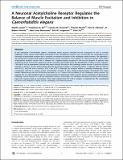| dc.contributor.author | Jospin, Maelle | |
| dc.contributor.author | Qi, Yingchuan B. | |
| dc.contributor.author | Stawicki, Tamara M. | |
| dc.contributor.author | Boulin, Thomas | |
| dc.contributor.author | Schuske, Kim R. | |
| dc.contributor.author | Bessereau, Jean-Louis | |
| dc.contributor.author | Jorgensen, Erik M. | |
| dc.contributor.author | Jin, Yishi | |
| dc.contributor.author | Horvitz, Howard Robert | |
| dc.date.accessioned | 2010-03-15T13:47:19Z | |
| dc.date.available | 2010-03-15T13:47:19Z | |
| dc.date.issued | 2009-12 | |
| dc.date.submitted | 2009-03 | |
| dc.identifier.issn | 1544-9173 | |
| dc.identifier.uri | http://hdl.handle.net/1721.1/52574 | |
| dc.description.abstract | In the nematode Caenorhabditis elegans, cholinergic motor neurons stimulate muscle contraction as well as activate GABAergic motor neurons that inhibit contraction of the contralateral muscles. Here, we describe the composition of an ionotropic acetylcholine receptor that is required to maintain excitation of the cholinergic motor neurons. We identified a gain-of-function mutation that leads to spontaneous muscle convulsions. The mutation is in the pore domain of the ACR-2 acetylcholine receptor subunit and is identical to a hyperactivating mutation in the muscle receptor of patients with myasthenia gravis. Screens for suppressors of the convulsion phenotype led to the identification of other receptor subunits. Cell-specific rescue experiments indicate that these subunits function in the cholinergic motor neurons. Expression of these subunits in Xenopus oocytes demonstrates that the functional receptor is comprised of three α-subunits, UNC-38, UNC-63 and ACR-12, and two non–α-subunits, ACR-2 and ACR-3. Although this receptor exhibits a partially overlapping subunit composition with the C. elegans muscle acetylcholine receptor, it shows distinct pharmacology. Recordings from intact animals demonstrate that loss-of-function mutations in acr-2 reduce the excitability of the cholinergic motor neurons. By contrast, the acr-2(gf) mutation leads to a hyperactivation of cholinergic motor neurons and an inactivation of downstream GABAergic motor neurons in a calcium dependent manner. Presumably, this imbalance between excitatory and inhibitory input into muscles leads to convulsions. These data indicate that the ACR-2 receptor is important for the coordinated excitation and inhibition of body muscles underlying sinusoidal movement. | en |
| dc.language.iso | en_US | |
| dc.publisher | Public Library of Science | en |
| dc.relation.isversionof | http://dx.doi.org/10.1371/journal.pbio.1000265 | en |
| dc.rights | Creative Commons Attribution | en |
| dc.rights.uri | http://creativecommons.org/licenses/by/2.5/ | en |
| dc.source | PLoS | en |
| dc.title | A Neuronal Acetylcholine Receptor Regulates the Balance of Muscle Excitation and Inhibition in Caenorhabditis elegans | en |
| dc.type | Article | en |
| dc.identifier.citation | Jospin, Maelle et al. “A Neuronal Acetylcholine Receptor Regulates the Balance of Muscle Excitation and Inhibition in Caenorhabditis elegans.” PLoS Biol 7.12 (2009): e1000265. | en |
| dc.contributor.department | Massachusetts Institute of Technology. Department of Biology | en_US |
| dc.contributor.department | McGovern Institute for Brain Research at MIT | en_US |
| dc.contributor.approver | Horvitz, H. Robert | |
| dc.contributor.mitauthor | Horvitz, H. Robert | |
| dc.relation.journal | PLoS Biology | en |
| dc.eprint.version | Final published version | en |
| dc.identifier.pmid | 20027209 | |
| dc.type.uri | http://purl.org/eprint/type/JournalArticle | en |
| eprint.status | http://purl.org/eprint/status/PeerReviewed | en |
| dspace.orderedauthors | Jospin, Maelle; Qi, Yingchuan B.; Stawicki, Tamara M.; Boulin, Thomas; Schuske, Kim R.; Horvitz, H. Robert; Bessereau, Jean-Louis; Jorgensen, Erik M.; Jin, Yishi | en |
| dc.identifier.orcid | https://orcid.org/0000-0002-9964-9613 | |
| mit.license | PUBLISHER_CC | en |
| mit.metadata.status | Complete | |
